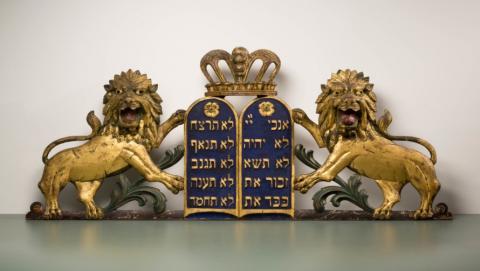Ethnography and Folklore
The Holiday Cycle
The exhibit begins with a display of symbols and motifs that have become an integral part of Jewish cultural heritage. Having influenced the design and ornamentation of articles used for religious and ritual purposes throughout the ages, the wide and varied use of these symbols provide a celebratory tour of the holiday cycle.
The diverse symbols in the exhibit include the iconic seven-branched candelabrum, as well as archetypes based on lions, shofars (ram's horns), etrogs (citrons), lulavs (palm fronds) and incense holders. Among the architectural motifs are schematic depictions of a gabled façade, paired columns, arch and conch shell, which symbolize the Temple in Jerusalem. Over time, these symbols were complemented by those of the Holy Tablets and the Star of David. A special display case illustrates the nexus of Christian, Muslim and Jewish creative art, as well as the influences created with the Jews' return to Israel in current times.
Rosh Hashana and Yom Kippur: examples of the shofars most widely found across the Jewish world, as well as a colorful variety of talitot (prayer shawls), prayer shawl collar pieces, buckles from cantors' belts and ornamented kipot(head coverings).
Succot (Feast of the Tabernacles): The character of this festival has been influenced by the practice of dwelling in succot (makeshift lodgings of palm fronds) during the holiday as well as the mitzva of the "Four Species." The imperative to protect the etrog, for example, gave rise to a variety of creative designs for vessels in which they would safely sit.
Passover: The Seder (Passover holiday meal) is the highlight of the seven-day holiday, and examples of items needed to fulfill its ritual requirements are displayed, including the a wide selection of cups in which the traditional four cups of wine are served, as well as the special Cup of the Prophet Elijah, and an assortment of decorative Seder plates.
Shavuot (Pentecost): The holiday's different names - harvest festival, the time of the granting of the Torah, the festival of the first fruits - have inspired multiple customs, symbols and concepts. Typical holiday decorations include paper cuts and ornaments used to decorate the Torah scroll.
Hanukkah: A fascinating display of typical Hanukkah lamps from European and Islamic countries underscore the wide variations of design found across Diaspora communities. Architectural motifs relating to the Temple in Jerusalem are prominent among designs of the eight-branch menorah, which recalls the tale of the container of oil that lasted eight days.
Purim: Like most ancient books, the Scroll of Esther (megilla), which is read on Purim, was written on parchment and rolled around a spindle with handles. Scrolls intended for reading at home were adorned with imaginative drawings and decorations based on the themes of the story of Esther. Megilla covers were an art form unto themselves. On display are also the porcelain and tin plates that were distinctively decorated and used for the Purim custom of distributing portions of food (mishloah manot).
The Sabbath: The variety of candlesticks used by women to welcome in the Sabbath as they light candles on Friday evening reflects the different traditions that developed around the Jewish world: silver and brass candlesticks from Eastern Europe, star-shaped oil lamps from Germany, Holland and Italy, and candleholders with pinched sides from Morocco. Sanctifying the wine (Kiddush) is also a traditional part of welcoming the Sabbath. Intricate wine goblets were made from silver and decorated with natural motifs, primarily grapevines, architectural designs and other embellishments. The spice box, part of the Havdala ceremony that concludes the Sabbath, comes in a variety of shapes and with a rich array of designs. The exhibit includes the most popular tower shape as well as flowers, fish and even railroad locomotives.
The Cycle of Jewish Life
The Jewish home and family ceremonies are as diverse as the communities that make up the Jewish world. The ingathering of Jews from so many locations during the great waves of immigration to Israel contributed to the creation of this fascinating collection. Among the cultural pieces a long the side corridors are ornate wedding costumes, jewelry, amulets used for protection and healing, and bags for prayer shawls and phylacteries presented to 13-year-old boys on the occasion of their Bar Mitzvah. The decorated ketubot(Jewish marriage contracts), embellished with ceremonial scenes as well as a variety of symbolic motifs, from the simple to the magnificent, reflect the couple's community of origin - Italy, Holland, the Ottoman Empire, Iran, Afghanistan, India and the Land of Israel.
The Trino Vercellese Synagogue Ark
A Holy Ark, or Torah Shrine, as it was called by Italian Jews, complete with its original Torah lectern, worshipers' benches, and the latticed railing from the women's balcony, is situated in a separate hall built according to the original synagogue plans. The Baroque and Rococo style of the Ark is typical of the Piedmont district of northwestern Italy and represents an excellent example of the influence of local style on historical Jewish themes. The set of doors carved with architectural images symbolizing the Temple still to be built in Jerusalem is the highlight of the Ark, expressing the centrality of Jerusalem in Jewish tradition.

